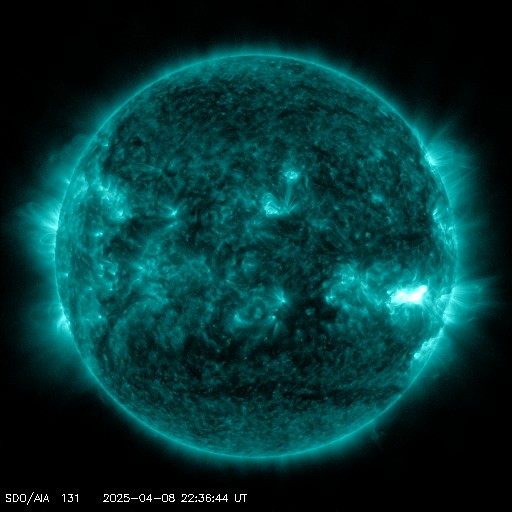Viewing archive of Tuesday, 22 February 2011
Solar activity report
Any mentioned solar flare in this report has a scaling factor applied by the Space Weather Prediction Center (SWPC). Because of the SWPC scaling factor, solar flares are reported as 42% smaller than for the science quality data. The scaling factor has been removed from our archived solar flare data to reflect the true physical units.
Report of Solar-Geophysical Activity 2011 Feb 22 2200 UTCPrepared by the NOAA © SWPC and processed by SpaceWeatherLive.com
Joint USAF/NOAA Report of Solar and Geophysical Activity
SDF Number 053 Issued at 2200Z on 22 Feb 2011IA. Analysis of Solar Active Regions and Activity from 21-2100Z to 22-2100Z
Solar activity has been very low. Region 1161 (N11W56)
decayed slightly but still maintained a beta-gamma magnetic
classification. Region 1162 (N17W59) was stable and quiet.
IB. Solar Activity Forecast
Solar activity is expected to be very
low to low. There is a chance for a C-class event from either Region
1161 or Region 1162.
IIA. Geophysical Activity Summary 21-2100Z to 22-2100Z
The geomagnetic field has been quiet during the past 24 hours. The
greater than 2 MeV electron flux at geosynchronous orbit reached
high levels during the period.
IIB. Geophysical Activity Forecast
The geomagnetic field is
expected to be predominately quiet on days one and two (23-24
February). Quiet to unsettled conditions are expected on day three
(25 February). The increase in activity is forecast due to the
expected slight increase in solar wind speed to around 480 km/s.
III. Event Probabilities 23 Feb to 25 Feb
| Class M | 05% | 05% | 05% |
| Class X | 01% | 01% | 01% |
| Proton | 01% | 01% | 01% |
| PCAF | Green | ||
IV. Penticton 10.7 cm Flux
Observed 22 Feb 091 Predicted 23 Feb-25 Feb 090/088/085 90 Day Mean 22 Feb 087
V. Geomagnetic A Indices
Observed Afr/Ap 21 Feb 007/007 Estimated Afr/Ap 22 Feb 002/005 Predicted Afr/Ap 23 Feb-25 Feb 005/005-005/005-007/008
VI. Geomagnetic Activity Probabilities 23 Feb to 25 Feb
| A. Middle Latitudes | |||
|---|---|---|---|
| Active | 10% | 10% | 15% |
| Minor storm | 01% | 01% | 01% |
| Major-severe storm | 01% | 01% | 01% |
| B. High Latitudes | |||
|---|---|---|---|
| Active | 10% | 10% | 15% |
| Minor storm | 01% | 01% | 05% |
| Major-severe storm | 01% | 01% | 01% |
All times in UTC
Current data suggests there is a slight possibility for aurora to appear at the following high latitude regions in the near future
TórshavnOulu, Rovaniemi, Sodankylä
Reykjavik
Tromsø, Trondheim
Arkhangelsk
Kiruna, Luleå, Sundsvall, Umeå
Latest news
Latest forum messages
Incoming & Unnumbered Active Regions 1678Sunspot Latitudes at or near Solar Maximum 85AR4048 126New satellites - Proba-3, PUNCH, SWFO-L1, GOES-U/19 47AR 4054 21
More topicsSupport SpaceWeatherLive.com!
A lot of people come to SpaceWeatherLive to follow the Sun's activity or if there is aurora to be seen, but with more traffic comes higher server costs. Consider a donation if you enjoy SpaceWeatherLive so we can keep the website online!

Latest alerts
22:42 UTC - Solar flare
Moderate M1.57 flare
22:24 UTC - Radio Blackout
Minor R1 radio blackout in progress (≥M1 - current: M1.52)
15:15 UTC - Geomagnetic activity
Minor G1 geomagnetic storm (Kp5) Threshold Reached: 14:59 UTC
06:30 UTC - Type II Radio Emission
Begin Time: 08/04/2025 05:53 UTC Estimated Velocity: 456km/sec.
05:15 UTC - Hemispheric Power Index
The OVATION model predicts the Hemispheric Power Index to reach 50GW at 06:02 UTC
Space weather facts
| Last X-flare | 2025/03/28 | X1.1 |
| Last M-flare | 2025/04/05 | M1.0 |
| Last geomagnetic storm | 2025/04/06 | Kp5 (G1) |
| Spotless days | |
|---|---|
| Last spotless day | 2022/06/08 |
| Monthly mean Sunspot Number | |
|---|---|
| March 2025 | 134.2 -20.4 |
| April 2025 | 151.3 +17.1 |
| Last 30 days | 137.4 +0.1 |




